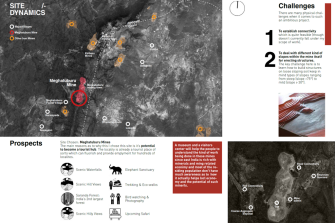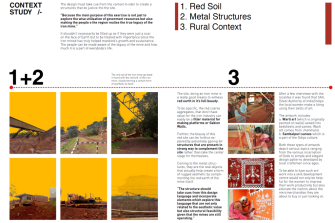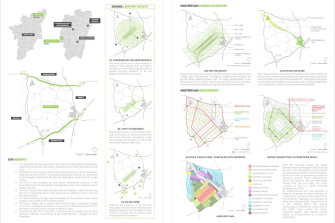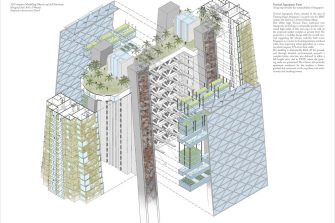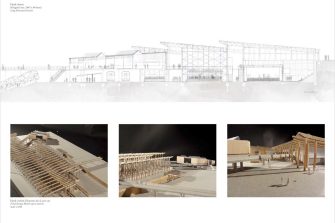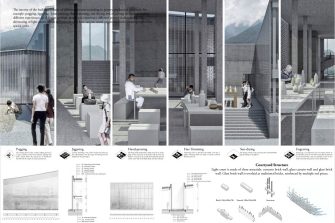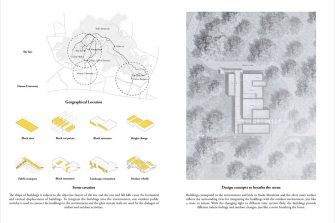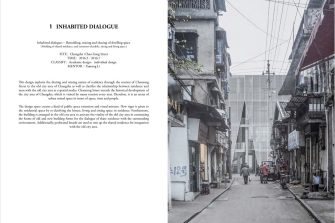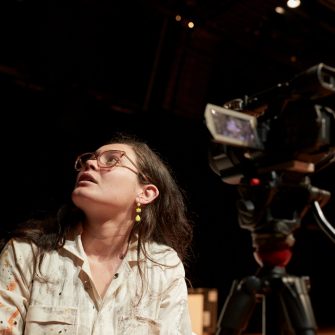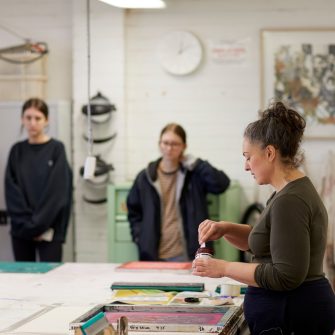Master of Architecture
- Commencing Terms
- Term 1 & 3
- Duration
- 2 Year(s)
- Delivery Mode
- Face-to-face (includes blended)
- Campus
-
Kensington
- Codes
- Program code 8143
- CRICOS code 061906G
-
Commonwealth Supported Places are available for this program2026 Indicative CSP first year fee
- $10,000*
-
2026 Indicative CSP fee to complete degree
- $20,000*
-
2026 Indicative first year full fee
- $48,500*
-
2026 Indicative full fee to complete degree
- $101,500*
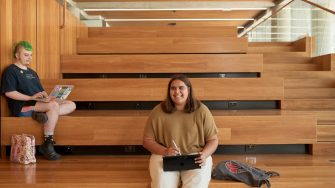
Application closures for 2026
Undergraduate programs for 2026 intakes are closed for New Overseas Student Commencement (NOSC) applications. Applications for postgraduate programs remain open. Find out if this closure applies to you.
- Overview
- Entry requirements
- What will I study?
- Future careers
- How to apply
- Fees & Scholarships
Overview
The UNSW Master of Architecture gives you a well-rounded architectural education to prepare you for a varied and fulfilling career in the profession. This two-year, full-time program builds on the foundations of the Bachelor of Architectural Studies. You’ll have the option to specialise in one of four architectural streams or cast your net wide by choosing studios and courses from across different architectural topics.
By completing this degree, you’ll develop professional knowledge in the practice of architecture, along with advanced skills and techniques in sustainability, designing with Indigenous communities, and innovative design thinking that you’ll draw on throughout your career. With world-renowned teaching staff, a structure created in consultation with industry, and our distinctive stream options, you’ll be prepared for an impactful career in architectural practice, and other exciting design-based industries.
If you’ve completed your bachelor’s degree and have ambitions to become a professional architect or want to work in other areas of design and the built environment, this master’s program is the choice for you.
Key features
Four distinctive streams
The Master of Architecture offers four distinctive streams that students can pick from when choosing studios and electives: high performance technology, housing, urban conditions and social agency. Students can pick different streams in each studio and for their electives, or choose to ‘specialise’ in one stream, to build focussed knowledge and expertise.
Flexible learning with time to work
Study your degree your way. Enjoy the flexibility of our trimester structure to suit your lifestyle and goals, whether it's full-time or part-time. Choose from a broad range of exciting electives from across the School of Built Environment, which can be taken at different times to suit your needs.
Practical training to maximise your employability
At UNSW, we’re known for producing Australia’s most employable graduates - we've been awarded Most Employable students for six years in a row (Australian Financial Review (AFR) Top100 Future Leaders Awards, 2020-2025). Foundational courses, such as The Profession of Architecture, will prepare you to seamlessly transition into the architectural workforce if you’re just starting out, or level up in your current role.
Focused on the future
With the world needing quality housing for 3 billion people by 2030 , architects will play an increasingly vital role in meeting housing demands in Australia and around the world. In the Master of Architecture, you’ll be empowered to create sustainable, economical and ethically responsible buildings that improve people’s lives, and are in tune with our climate and environment.
Why study at UNSW?
Graduate from a global top 20 university
Upon successful completion of the UNSW Master of Architecture, you’ll have an internationally recognised qualification from a top-ranking university – UNSW is ranked #20 university in the world (QS World University Rankings, 2026). Also, we're ranked #1 in Sydney and #23 globally for architecture & built environment (QS World University Rankings by Subject, 2025).
Expand your mind with industry partnerships and world-class teachers
Learn from award-winning architects, such as UNSW Professor of Practice Rachel Neeson, a recipient of the Marion Mahony Griffin Prize by the Australian Institute of Architects and UNSW Seidler Chairs in the Practice of Architecture Richard Hassell and Wong Mun Summ (Founders of WOHA, Singapore) and winners of ‘World Architecture Festival - World Building of the Year’, and ‘Best Tall Building Worldwide’. UNSW is also the only Australian university that offers Master of Architecture students an internship at Renzo Piano Building Workshop in Genoa, Italy. Hear from world-renowned practitioners from around the globe as part of our UNSW Utzon Lecture series.
Solve tomorrow’s problems using advanced facilities and technologies
Take advantage of our industry-leading facilities. You’ll learn vital digital skills for design and automation from the ARC Next-Gen Architectural Manufacturing Centre. Discover how advanced technologies such as Artificial Intelligence and Machine Learning will vitally improve the industry’s productivity, performance and sustainability.
Award winning students
Our graduates receive the highest recognition for their achievements, being recently awarded the 2023 NSW Architects Registration Board Architect’s Medallion and the 2023 NSW Australian Institute of Architects Graduate Medal, Architectural Technologies Award and Students’ Choice Award.
Hear from our students
“We had lecturers and tutors from the real world who were practicing architects. And we had mentoring programs. Students would pair up with an architect that was working and meet them once every few months, and we got to see real projects and got a really good taste of what the profession was like."
Jensen Che, Architect, Master of Architecture
Want to see more from UNSW Arts, Design & Architecture?
Entry requirements
To be eligible, you must have completed a nationally accredited undergraduate degree in architecture, such as the UNSW Bachelor of Architectural Studies (or equivalent), with a minimum credit average (65 WAM).
If you do not meet the academic entry requirements, you may still be considered based on relevant work experience in combination with your undergraduate architectural studies.
If you study the UNSW Bachelor of Interior Architecture (Honours) you can be eligible for the Master of Architecture if you undertake the architecture elective pathway and achieve an overall WAM of 65. However, if you've never studied architecture at a tertiary level, you should consider applying for the Bachelor of Architectural Studies.
-
Applicants who have completed the Bachelor of Architectural Studies (or equivalent) but do not meet the entry requirements specified above may be considered after they have obtained work experience in an architectural office.
Work experience will be individually assessed based on the following submission:
- A logbook record of a minimum 12 months full-time work or the equivalent
- A referee report from the employer
- A portfolio of the work undertaken during this period.
If you study the UNSW Bachelor of Interior Architecture (Honours) you can be eligible for the Master of Architecture if you undertake the architecture elective pathway and achieve an overall WAM of 65. However, if you've never studied architecture at a tertiary level, you should consider applying for the Bachelor of Architectural Studies.
Bachelor of Interior Architecture (Honours) graduates who do not meet the above may be considered after they have obtained five years of work experience in an architectural office or equivalent. Work experience will be individually assessed based on the following submission:
- A logbook of a minimum of 5 years full-time work of the equivalent (completed after their bachelor's degree)
- A referee report from the employer
- A portfolio of work (including engagement with architectural construction specifically)
-
UNSW Bachelor of Interior Architecture (Honours) graduates will meet entry requirements for the Master of Architecture if they complete the architecture elective pathway in the Bachelor of Interior Architecture (Honours) degree.
Students will need to complete the following courses as part of this pathway and achieve an overall WAM of 65. These courses will count as electives in their Bachelor of Interior Architecture program:
- ARCH1311 Architectural Studio 5
- ARCH1302 Architectural Studio 6
- ARCH1261 Structures and Construction 2
- ARCH1322 Architectural History and Theory 3
- ARCH1361 Architectural Science and Building Environment 2
Portfolio requirement
If you completed your undergraduate architecture degree at an international university, you must provide a portfolio of design work. The portfolio must:
- include sample works from various stages of your undergraduate degree and any professional work
- have drawings and/or images accompanied with text to explain the projects
- be in a digital format.
-
Good portfolio content demonstrates:
- The issues the design wants to solve. For example: societal inequality, environmental constraints, economic conditions, pollution.
- The opportunities the design wants to expand. For example: local resources, natural light, public transportation.
- The decision-making process that led to the final outcome.
- The final design product and outcome presented with appropriate sets of drawings such as plans, sections, elevations, perspectives, and pictures from physical models.
- Technical understanding underpinning the design, that is, the structure, construction, and materials chosen.
Only if all these points are clearly explained it is possible for us to assess the ‘thinking’ behind your work. These points can be presented through site analysis, development diagrams, and technical drawings.
-
A site analysis will show the problems and the opportunities in the site where a project is developed.
A good site analysis uses many drawings to show the background information that informed the decision-making process of a project - for example, sun-path, wind directions, infrastructures available, population type, physical constraints, etc. A good site analysis will show problems and site characteristics that your design wants to solve or address.
-
A development diagram shows how the final version of the building or infrastructure has been developed. These diagrams need to convey why you chose to design the building in that way.
-
Technical drawings show how the projects can be built. These drawings explain how the building stands up, and how the building is constructed.
-
The final design product needs to be displayed appropriately with all sets of essential drawings to show the qualitative value of each project.
Plans, sections, elevations, perspectives need to be legible, neat, and beautifully descriptive. Pictures from physical models can also be included to improve the tridimensional value and materiality of each design.
-
A good portfolio presentation involves curation, organisation and communication.
Curation
Show only your best work - don’t include everything. Aim to create a graphically beautiful document with one consistent graphic style.Organisation
Put your most recent work first. Make it clear which projects were academic, and which projects were professional. Remember to mention your contribution to group and professional projects.Communication
The images and drawings should speak for themselves, and the accompanying written descriptions should be succinct. The text, images and drawings must be clearly visible.- Use more pages rather than clutter less pages
- Edit professional project drawings to match your portfolio's graphic style
- Avoid using bright colours for text, or placing text on detailed or contrasting backgrounds.
English language requirements
You may be asked to provide evidence of your English proficiency to study at UNSW depending on your educational background and citizenship. English language skills are vitally important for coping with lectures, tutorials, assignments and examinations - this is why UNSW requires a minimum English language competency for enrolment.
If you’re completing an Australian Year 12 qualification (e.g. NSW HSC or equivalent), you do not need to provide anything extra to prove your proficiency. Your qualification will be used as evidence of your English proficiency.
If you do need to provide evidence of your English proficiency, this will be indicated in your application. You can prove this by providing evidence that you meet one or more of the following criteria:
- English language tests and university English courses
- Prior study in the medium of English
- Other qualifications
If you need to improve your English skills before you start your degree, UNSW College’s Academic English Programs are for you. The programs are suitable for various English levels and help you prepare for university studies and life in Australia.
For more details, visit the English Language Requirements page.
You will need to have completed a nationally accredited undergraduate degree (or equivalent) in architecture with grades at a consistent credit level (65 WAM) or higher. If you don't meet the entry requirements, you may be able to demonstrate work experience combined with undergraduate studies in architecture instead.
If you study the UNSW Bachelor of Interior Architecture (Honours) you can be eligible for the Master of Architecture if you undertake the architecture elective pathway and achieve an overall WAM of 65. However, if you've never studied architecture at a tertiary level, you should consider applying for the Bachelor of Architectural Studies.
-
Applicants who have completed the Bachelor of Architectural Studies (or equivalent) but do not meet the entry requirements specified above may be considered after they have obtained work experience in an architectural office.
Work experience will be individually assessed based on the following submission:
- A logbook record of a minimum 12 months full-time work or the equivalent
- A referee report from the employer
- A portfolio of the work undertaken during this period.
-
UNSW Bachelor of Interior Architecture (Honours) graduates will meet entry requirements for the Master of Architecture if they complete the architecture elective pathway in the Bachelor of Interior Architecture (Honours) degree.
Students will need to complete the following courses as part of this pathway and achieve an overall WAM of 65. These courses will count as electives in their Bachelor of Interior Architecture program:
- ARCH1311 Architectural Studio 5
- ARCH1302 Architectural Studio 6
- ARCH1261 Structures and Construction 2
- ARCH1322 Architectural History and Theory 3
- ARCH1361 Architectural Science and Building Environment 2
Portfolio requirement
If you completed your undergraduate architecture degree at an international university, you must provide a portfolio of design work. The portfolio must:
- include sample works from various stages of your undergraduate degree and any professional work
- have drawings and/or images accompanied with text to explain the projects
- be in a digital format.
-
Good portfolio content demonstrates:
- The issues the design wants to solve. For example: societal inequality, environmental constraints, economic conditions, pollution.
- The opportunities the design wants to expand. For example: local resources, natural light, public transportation.
- The decision-making process that led to the final outcome.
- The final design product and outcome presented with appropriate sets of drawings such as plans, sections, elevations, perspectives, and pictures from physical models.
- Technical understanding underpinning the design, that is, the structure, construction, and materials chosen.
Only if all these points are clearly explained it is possible for us to assess the ‘thinking’ behind your work. These points can be presented through site analysis, development diagrams, and technical drawings.
-
A site analysis will show the problems and the opportunities in the site where a project is developed.
A good site analysis uses many drawings to show the background information that informed the decision-making process of a project - for example, sun-path, wind directions, infrastructures available, population type, physical constraints, etc. A good site analysis will show problems and site characteristics that your design wants to solve or address.
-
A development diagram shows how the final version of the building or infrastructure has been developed. These diagrams need to convey why you chose to design the building in that way.
-
Technical drawings show how the projects can be built. These drawings explain how the building stands up, and how the building is constructed.
-
The final design product needs to be displayed appropriately with all sets of essential drawings to show the qualitative value of each project.
Plans, sections, elevations, perspectives need to be legible, neat, and beautifully descriptive. Pictures from physical models can also be included to improve the tridimensional value and materiality of each design.
-
A good portfolio presentation involves curation, organisation and communication.
Curation
Show only your best work - don’t include everything. Aim to create a graphically beautiful document with one consistent graphic style.Organisation
Put your most recent work first. Make it clear which projects were academic, and which projects were professional. Remember to mention your contribution to group and professional projects.Communication
The images and drawings should speak for themselves, and the accompanying written descriptions should be succinct. The text, images and drawings must be clearly visible.- Use more pages rather than clutter less pages
- Edit professional project drawings to match your portfolio's graphic style
- Avoid using bright colours for text, or placing text on detailed or contrasting backgrounds.
English language requirements
You may be asked to provide evidence of your English proficiency to study at UNSW depending on whether you are from an English-speaking background or non-English speaking background. English language skills are vitally important for coping with lectures, tutorials, assignments and examinations - this is why UNSW requires a minimum English language competency for enrolment.
If English is not your first language, you’ll need to provide proof of your English proficiency before you can be given an offer to study at UNSW. You can do this by providing evidence that you meet one or more of the following criteria:
- English language tests and university English courses
- Prior study in the medium of English
- Other qualifications
If you need to improve your English skills before you start your degree, UNSW College’s Academic English Programs are for you. The programs are suitable for various English levels and help you prepare for university studies and life in Australia.
For more details, visit the English Language Requirements page.
Check the specific English language requirements for this program
What will I study?
UNSW is introducing a new academic calendar from 2028.
We are moving to a new flex-semester calendar. What does this mean for your studies?
Program structure
The UNSW Master of Architecture degree gives you a professional education in architectural design and practice. With full-time study, you’ll typically complete this program in two years. This industry-aligned degree has been designed to give you an architectural education that will fast-track your success in contemporary professional practice.
Building on the disciplinary foundation established by the Bachelor of Architectural Studies, the Master of Architecture gives you the option of pursuing one of four specialised streams. You can also complete the program without a specialised stream.
Full program structure
This program contains a total of 96 units of credit (UOC) and can be completed in 2 years with full-time study or 2.7 to 4 years with part-time study. Students must complete:
8 courses – 48 UOC
Specialisation – 48 UOC
High Performance Technology – focuses on the design of buildings with an emphasis on sustainability and environmental performance
Housing – focuses on the design of housing and hybrid building types incorporating housing
Urban Conditions – focuses on the design of buildings and precincts in the context of the contemporary city and the relationship of buildings to the public domain
Social Agency – focuses on design in a humanitarian context including issues of social displacement or alienation.
Alternatively, students can opt not to pursue a specialisation and instead select the general ‘Architecture’ stream, where they’ll be able to choose from a selection of different studios and electives from across the different specialisations above.
Future careers
Studying architecture in Australia at UNSW gives you the professional experience and vital skills to shape the culture of buildings, places and the environment.
After completing your studies and working in a professional setting for around 2 years, you can apply for registration as an architect. You’ll do this through the Architects Accreditation Council of Australia’s Architectural Practice Examination (APE). Once you pass the APE, you can register with the relevant state Architects Registration Board and become a registered architect. You can also qualify with the Australian Institute of Architects and the Commonwealth Association of Architects.
A Master of Architecture completed in Australia also provides a pathway to work as a registered architect in many other countries, such as Canada, Japan, Singapore, the UK and the USA.
You’ll have a unique advantage in the workforce and can choose from a selection of various career paths.
Potential careers
Setting up your own private architectural practice
Commercial architectural practice with diverse areas of focus, from single family homes to skyscrapers
Architect in housing, high-performance architectural technology or humanitarian architecture
Architectural project manager for a private firm
Expert consultant in government, policy or the environment
Multidisciplinary design practice
Architectural critic, journalist, historian and academic
Accreditation
UNSW’s Master of Architecture is accredited by the Architects Accreditation Council of Australia. Upon completion, students will be on the pathway to becoming a registered architect.
How to apply
Applications must be submitted through our Apply Online portal. We encourage you to submit your completed application as early as possible to ensure it will be processed in time for your preferred term. Some high-demand programs and Faculties with limited places may have an earlier application deadline or commencement date. Find out more.
Please refer to the Entry requirements tab for further information regarding any additional application requirements.
Ready to start your application?
For most international students, applications are submitted via our Apply Online service. We encourage you to submit your completed application as early as possible to ensure it will be processed in time for your preferred term.
Some high-demand programs with limited places, may have an earlier application deadline or may have an earlier commencement date. For details, visit the international admissions information page.
Please refer to the Entry requirements tab for further information regarding any additional application requirements.
Ready to start your application?
Fees & Scholarships
There are a limited number of Commonwealth Supported Places (CSP) available for this degree/program. Your eligibility to receive a CSP will be automatically assessed when you apply. Please note that eligibility for Commonwealth Supported Places (CSPs) is competitive, with places awarded based on academic merit. Start your postgraduate application today with our guide on how to apply.
Commonwealth Study Assistance such as Austudy, and Youth Allowance is available for some master’s degrees. For the most up-to-date information and list of degrees visit UNSW Current Student Financial Support.
*The indicative Commonwealth Supported Place (CSP) fees are an estimate based on the relevant student contribution band/s for a Commonwealth Supported Place undertaking a standard full-time load of 48 units of credit per year (1 Equivalent Full Time Student Load/1 EFTSL). To find out more about Commonwealth Supported Places visit Postgraduate Commonwealth Support.
Indicative fees are a guide only and have been calculated based on the typical enrolment patterns of students undertaking the degree/program. The indicative fee listed here is an estimate for tuition only and excludes non-tuition fees and charges. The amount you pay will vary depending on the calendar year of enrolment, the courses you select and whether your study load is more or less than 1 Equivalent Full Time Student Load (48 units of credit (UOC) per year).
You should not rely on indicative fees as fee increases are assessed when required and may exceed the indicative figures listed here. Actual fees are calculated on enrolment. More information on fees can be found at the UNSW fees website.
*Fees are subject to annual review by the University and may increase annually, with the new fees effective from the start of each calendar year. The indicative fees listed here are based on an estimated average and are for tuition only, other fees and charges are not included. The amount you pay will vary depending on the calendar year to enrol, the courses you select and whether your study load is more or less than 1 Equivalent Full Time Student Load (8 courses per year).
Indicative fees are a guide for comparison only based on current conditions and available data. You should not rely on indicative fees. More information on fees can be found at the UNSW fees website.
Indicative fees to complete the program have been calculated based on a percentage increase for every year of the program. Fee increases are assessed annually and may exceed the indicative figures listed here.
Indicative fees to complete the program include tuition plus an estimate of study-related costs of approximately $1,000 per year. To find out more about other costs, visit UNSW International.
Scholarships
At UNSW, we award over $83 million in scholarships each year. We pride ourselves on rewarding excellence and making university accessible to students from all walks of life. Whether you’re a domestic or international student, our range of scholarships, prizes and awards can support your journey.
Progress starts here – at a world-leading university

Top 20 Worldwide
Ranked in the global top 20 for three consecutive years
QS World University Rankings, 2024–2026

Winner of the AFR Most Employable University Award six years in a row
AFR Top100 Future Leaders Awards, 2020–2025

Australia's #1 for Innovation
Highest number of startups and spinouts from university-developed tech
SCOPR report, 2024

